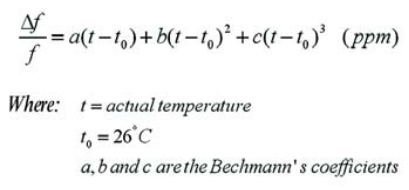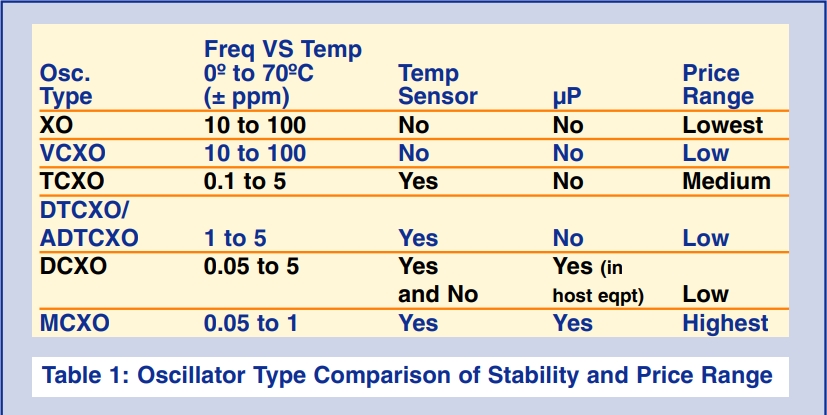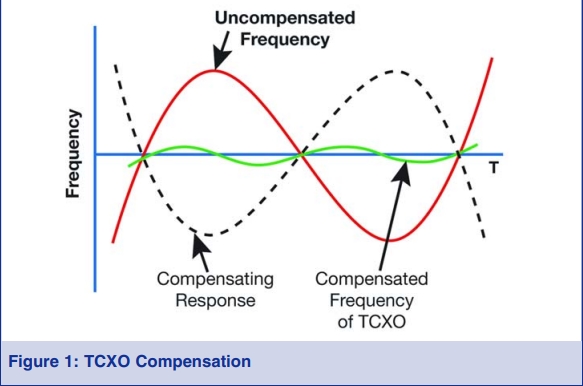Crystek TCXO温补晶振数据手册
Crystek TCXO温补晶振数据手册,在偌大的市场之中,Crystek公司不断调整自身的定位,经过长期的积累,以及对于电子元器件行业的深度剖析,使得其能将目光移动到电信应用,并针对性开发系列高品质的有源晶体振荡器,随之为了凸显产品的性能,开发新颖的TCXO温补晶振,正是因为对于产品的不懈追求,Crystek才能不断挑战自我的极限,开发适合市场发展的优质产品.
温度补偿晶体振荡器在今天的无线通信系统。它们已成为重要组成部分移动电话和不断增长的无线PDA行业。高端TCXO也是电信和其他行业。
TCXO温度补偿晶体振荡器和一个简单的晶体振荡器TCXO包含额外的校正(补偿)电路晶体的频率对温度的特性。图1描绘了关于水晶的简单说明被校正。附加补偿电路分为三个主要类别:数字、模拟或模拟/数字组合。了解差异数字和模拟之间的补偿很重要,因为在某些情况下箱子,不能互换。
未补偿频率图1所示的稳定性是典型的AT切割石英晶体。它实际上是一组曲线,主要由切割晶体坯料的角度决定。这些曲线遵循形式为:

商品TCXO可从+/-在-40ºC至+85ºC范围内,1.5ppm至+/-5ppm频率稳定性最高标准规格为+/-2.5ppm以上-30ºC至+75ºC。频率稳定性在0ºC至+70ºC范围内低于+/-1.5ppm很难实现,因此跌倒进入高性能类别。商品TCXO晶振通常成本更低超过8美元,同时具有高性能TCXO通常为15美元或以上。
商品TCXO可以以非常小的包装制造,例如5x3.2x1.5mm,甚至3.2x2.5x1mm更小的尺寸即将出现。这些微型振荡器都是基于ASIC大批量生产。由于使用的特定ASIC,晶体振荡器公司不能提供任何自定义(频率除外)在家庭范围内。此外,所有这些小型TCXO实际上都是VCTCXO——也就是说,它们提供了用于电气调谐或偏差的引脚。
这些上的输出波形选项微小的TCXO仅限于削波正弦或仅正弦波。如果您需要例如,HCMOS是可用的仅适用于较大的包装。高性能TCXO有源晶振可用于所有流行的波形选项(正弦波、HCMOS、LVPECL等)。削波后的正弦波形有一个与其他波形相比的主要优势:电流消耗。削波正弦的典型电流消耗最大为2mA在+3V。内部削波正弦驱动器只是来源于的收集器双极晶体管。这意味着振荡器所看到的负载必须是高阻抗的;通常它需要10K欧姆负载。削波正弦驱动器非常适合直接驱动PLL IC,提供低电流解决方案。Crystek TCXO温补晶振数据手册.
原厂代码
品牌
型号
类型
频率
频率稳定度
工作温度
CE3390-24.000
Crystek Corporation
C33
XO (Standard)
24MHz
±100ppm
-40°C ~ 85°C
CE3390-24.704
Crystek Corporation
C33
XO (Standard)
24.704MHz
±100ppm
-40°C ~ 85°C
CE3390-25.000
Crystek Corporation
C33
XO (Standard)
25MHz
±100ppm
-40°C ~ 85°C
CE3390-3.686400
Crystek Corporation
C33
XO (Standard)
3.6864MHz
±100ppm
-40°C ~ 85°C
CE3390-30.000
Crystek Corporation
C33
XO (Standard)
30MHz
±100ppm
-40°C ~ 85°C
CE3390-32.000
Crystek Corporation
C33
XO (Standard)
32MHz
±100ppm
-40°C ~ 85°C
CE3390-32.768
Crystek Corporation
C33
XO (Standard)
32.768MHz
±100ppm
-40°C ~ 85°C
CE3390-33.000
Crystek Corporation
C33
XO (Standard)
33MHz
±100ppm
-40°C ~ 85°C
CE3390-33.333
Crystek Corporation
C33
XO (Standard)
33.333MHz
±100ppm
-40°C ~ 85°C
CE3390-35.000
Crystek Corporation
C33
XO (Standard)
35MHz
±100ppm
-40°C ~ 85°C
CE3390-4.000
Crystek Corporation
C33
XO (Standard)
4MHz
±100ppm
-40°C ~ 85°C
CE3390-40.000
Crystek Corporation
C33
XO (Standard)
40MHz
±100ppm
-40°C ~ 85°C
CE3390-6.176
Crystek Corporation
C33
XO (Standard)
6.176MHz
±100ppm
-40°C ~ 85°C
CE3390-7.372800
Crystek Corporation
C33
XO (Standard)
7.3728MHz
±100ppm
-40°C ~ 85°C
CE3390-8.000
Crystek Corporation
C33
XO (Standard)
8MHz
±100ppm
-40°C ~ 85°C
CE3292-1.544
Crystek Corporation
C3292
XO (Standard)
1.544MHz
±50ppm
-40°C ~ 85°C
CE3292-1.843200
Crystek Corporation
C3292
XO (Standard)
1.8432MHz
±50ppm
-40°C ~ 85°C
CE3292-10.000
Crystek Corporation
C3292
XO (Standard)
10MHz
±50ppm
-40°C ~ 85°C
CE3292-12.000
Crystek Corporation
C3292
XO (Standard)
12MHz
±50ppm
-40°C ~ 85°C
CE3292-12.288
Crystek Corporation
C3292
XO (Standard)
12.288MHz
±50ppm
-40°C ~ 85°C
CE3292-12.352
Crystek Corporation
C3292
XO (Standard)
12.352MHz
±50ppm
-40°C ~ 85°C
CE3292-14.318180
Crystek Corporation
C3292
XO (Standard)
14.31818MHz
±50ppm
-40°C ~ 85°C
CE3292-15.360
Crystek Corporation
C3292
XO (Standard)
15.36MHz
±50ppm
-40°C ~ 85°C
CE3292-16.0000
Crystek Corporation
C3292
XO (Standard)
16MHz
±50ppm
-40°C ~ 85°C
CE3292-16.384
Crystek Corporation
C3292
XO (Standard)
16.384MHz
±50ppm
-40°C ~ 85°C
CE3292-18.432
Crystek Corporation
C3292
XO (Standard)
18.432MHz
±50ppm
-40°C ~ 85°C
CE3292-19.440
Crystek Corporation
C3292
XO (Standard)
19.44MHz
±50ppm
-40°C ~ 85°C
CE3292-2.048
Crystek Corporation
C3292
XO (Standard)
2.048MHz
±50ppm
-40°C ~ 85°C
CE3292-20.000
Crystek Corporation
C3292
XO (Standard)
20MHz
±50ppm
-40°C ~ 85°C
CE3292-20.480
Crystek Corporation
C3292
XO (Standard)
20.48MHz
±50ppm
-40°C ~ 85°C
CE3292-24.000
Crystek Corporation
C3292
XO (Standard)
24MHz
±50ppm
-40°C ~ 85°C
CE3292-24.704
Crystek Corporation
C3292
XO (Standard)
24.704MHz
±50ppm
-40°C ~ 85°C
CE3292-25.000
Crystek Corporation
C3292
XO (Standard)
25MHz
±50ppm
-40°C ~ 85°C
CE3292-3.686400
CRYSTEK晶振
C3292
XO (Standard)
3.6864MHz
±50ppm
-40°C ~ 85°C
CE3292-30.000
Crystek Corporation
C3292
XO (Standard)
30MHz
±50ppm
-40°C ~ 85°C
CE3292-32.000
Crystek Corporation
C3292
XO (Standard)
32MHz
±50ppm
-40°C ~ 85°C
CE3292-32.768
Crystek Corporation
C3292
XO (Standard)
32.768MHz
±50ppm
-40°C ~ 85°C
CE3292-33.000
Crystek Corporation
C3292
XO (Standard)
33MHz
±50ppm
-40°C ~ 85°C
CE3292-33.333
Crystek Corporation
C3292
XO (Standard)
33.333MHz
±50ppm
-40°C ~ 85°C
CE3292-35.000
Crystek Corporation
C3292
XO (Standard)
35MHz
±50ppm
-40°C ~ 85°C
CE3292-4.000
Crystek Corporation
C3292
XO (Standard)
4MHz
±50ppm
-40°C ~ 85°C
CE3292-40.000
Crystek Corporation
C3292
XO (Standard)
40MHz
±50ppm
-40°C ~ 85°C
CE3292-6.176
Crystek Corporation
C3292
XO (Standard)
6.176MHz
±50ppm
-40°C ~ 85°C
CE3292-7.372800
Crystek Corporation
C3292
XO (Standard)
7.3728MHz
±50ppm
-40°C ~ 85°C
CE3292-8.000
Crystek Corporation
C3292
XO (Standard)
8MHz
±50ppm
-40°C ~ 85°C
CE3392-1.544
Crystek Corporation
C33
XO (Standard)
1.544MHz
±50ppm
-40°C ~ 85°C
CE3392-1.843200
Crystek Corporation
C33
XO (Standard)
1.8432MHz
±50ppm
-40°C ~ 85°C
CE3392-10.000
Crystek Corporation
C33
XO (Standard)
10MHz
±50ppm
-40°C ~ 85°C
CE3392-12.000
Crystek Corporation
C33
XO (Standard)
12MHz
±50ppm
-40°C ~ 85°C
CE3392-12.288
Crystek Corporation
C33
XO (Standard)
12.288MHz
±50ppm
-40°C ~ 85°C
CE3392-12.352
Crystek Corporation
C33
XO (Standard)
12.352MHz
±50ppm
-40°C ~ 85°C
CE3392-14.318180
Crystek Corporation
C33
XO (Standard)
14.31818MHz
±50ppm
-40°C ~ 85°C
CE3392-15.360
Crystek Corporation
C33
XO (Standard)
15.36MHz
±50ppm
-40°C ~ 85°C
CE3392-16.0000
Crystek Corporation
C33
XO (Standard)
16MHz
±50ppm
-40°C ~ 85°C
CE3392-16.384
Crystek Corporation
C33
XO (Standard)
16.384MHz
±50ppm
-40°C ~ 85°C
CE3392-18.432
Crystek Corporation
C33
XO (Standard)
18.432MHz
±50ppm
-40°C ~ 85°C
CE3392-19.440
Crystek Corporation
C33
XO (Standard)
19.44MHz
±50ppm
-40°C ~ 85°C
CE3392-2.048
Crystek Corporation
C33
XO (Standard)
2.048MHz
±50ppm
-40°C ~ 85°C
CE3392-20.000
Crystek Corporation
C33
XO (Standard)
20MHz
±50ppm
-40°C ~ 85°C
CE3392-20.480
Crystek Corporation
C33
XO (Standard)
20.48MHz
±50ppm
-40°C ~ 85°C
CE3392-24.000
Crystek Corporation
C33
XO (Standard)
24MHz
±50ppm
-40°C ~ 85°C
CE3392-24.704
Crystek Corporation
C33
XO (Standard)
24.704MHz
±50ppm
-40°C ~ 85°C
CE3392-25.000
Crystek Corporation
C33
XO (Standard)
25MHz
±50ppm
-40°C ~ 85°C
CE3392-3.686400
Crystek Corporation
C33
XO (Standard)
3.6864MHz
±50ppm
-40°C ~ 85°C
CE3392-30.000
Crystek Corporation
C33
XO (Standard)
30MHz
±50ppm
-40°C ~ 85°C
CE3392-32.000
Crystek Corporation
C33
XO (Standard)
32MHz
±50ppm
-40°C ~ 85°C
CE3392-32.768
Crystek Corporation
C33
XO (Standard)
32.768MHz
±50ppm
-40°C ~ 85°C
CE3392-33.000
Crystek Corporation
C33
XO (Standard)
33MHz
±50ppm
-40°C ~ 85°C
CE3392-33.333
Crystek Corporation
C33
XO (Standard)
33.333MHz
±50ppm
-40°C ~ 85°C
CE3392-35.000
Crystek Corporation
C33
XO (Standard)
35MHz
±50ppm
-40°C ~ 85°C
CE3392-4.000
Crystek Corporation
C33
XO (Standard)
4MHz
±50ppm
-40°C ~ 85°C
CE3392-40.000
Crystek Corporation
C33
XO (Standard)
40MHz
±50ppm
-40°C ~ 85°C
CE3392-6.176
Crystek Corporation
C33
XO (Standard)
6.176MHz
±50ppm
-40°C ~ 85°C
CE3392-7.372800
Crystek Corporation
C33
XO (Standard)
7.3728MHz
±50ppm
-40°C ~ 85°C
CE3392-8.000
Crystek Corporation
C33
XO (Standard)
8MHz
±50ppm
-40°C ~ 85°C
C3392-80.000
Crystek Corporation
C33
XO (Standard)
80MHz
±50ppm
0°C ~ 70°C
C3291-1.544
Crystek Corporation
C3291
XO (Standard)
1.544MHz
±25ppm
0°C ~ 70°C
C3291-1.843200
Crystek Corporation
C3291
XO (Standard)
1.8432MHz
±25ppm
0°C ~ 70°C
C3291-10.000
Crystek Corporation
C3291
XO (Standard)
10MHz
±25ppm
0°C ~ 70°C
C3291-12.000
Crystek Corporation
C3291
XO (Standard)
12MHz
±25ppm
0°C ~ 70°C
C3291-12.288
Crystek Corporation
C3291
XO (Standard)
12.288MHz
±25ppm
0°C ~ 70°C
C3291-12.352
Crystek Corporation
C3291
XO (Standard)
12.352MHz
±25ppm
0°C ~ 70°C
C3291-14.318180
Crystek Corporation
C3291
XO (Standard)
14.31818MHz
±25ppm
0°C ~ 70°C
C3291-15.360
Crystek Corporation
C3291
XO (Standard)
15.36MHz
±25ppm
0°C ~ 70°C
C3291-16.000
Crystek Corporation
C3291
XO (Standard)
16MHz
±25ppm
0°C ~ 70°C
C3291-16.384
Crystek Corporation
C3291
XO (Standard)
16.384MHz
±25ppm
0°C ~ 70°C
C3291-18.432
Crystek Corporation
C3291
XO (Standard)
18.432MHz
±25ppm
0°C ~ 70°C
C3291-19.440
Crystek Corporation
C3291
XO (Standard)
19.44MHz
±25ppm
0°C ~ 70°C
C3291-2.048
Crystek Corporation
C3291
XO (Standard)
2.048MHz
±25ppm
0°C ~ 70°C
C3291-20.000
Crystek Corporation
C3291
XO (Standard)
20MHz
±25ppm
0°C ~ 70°C
C3291-20.480
Crystek Corporation
C3291
XO (Standard)
20.48MHz
±25ppm
0°C ~ 70°C
C3291-24.000
Crystek Corporation
C3291
XO (Standard)
24MHz
±25ppm
0°C ~ 70°C
C3291-24.704
Crystek Corporation
C3291
XO (Standard)
24.704MHz
±25ppm
0°C ~ 70°C
C3291-25.000
Crystek Corporation
C3291
XO (Standard)
25MHz
±25ppm
0°C ~ 70°C
C3291-3.686400
Crystek Corporation
C3291
XO (Standard)
3.6864MHz
±25ppm
0°C ~ 70°C
C3291-30.000
Crystek Corporation
C3291
XO (Standard)
30MHz
±25ppm
0°C ~ 70°C
C3291-32.000
Crystek Corporation
C3291
XO (Standard)
32MHz
±25ppm
0°C ~ 70°C
C3291-32.768
Crystek Corporation
C3291
XO (Standard)
32.768MHz
±25ppm
0°C ~ 70°C
C3291-33.000
Crystek Corporation
C3291
XO (Standard)
33MHz
±25ppm
0°C ~ 70°C
C3291-33.333
Crystek Corporation
C3291
XO (Standard)
33.333MHz
±25ppm
0°C ~ 70°C
C3291-35.000
Crystek Corporation
C3291
XO (Standard)
35MHz
±25ppm
0°C ~ 70°C
有四种数字实现(和一种基本模拟)类型。这些如下所示:
TCXO–温度补偿晶体振荡器(见图2)
ADTCXO–模拟数字温度补偿晶体振荡器(见图3
DAC和逻辑替换为三次函数和模拟放大器)
DTCXO–数字温度补偿晶体振荡器(见图3)
MCXO–微处理器补偿晶体振荡器(见图4)
DCXO–数字控制晶体振荡器
图3中的ADTCXO是目前在手机行业使用的型号,有5x3.2x1.5mm并且更小。这些振荡器也是由于其体积小、成本低,被设计用于所有类型的设备费用但是,设计师要小心:图3的DTCXO版本和其他数字实现,阶段将发生命中(突然的相位变化)当振荡器进行校正时因为它感应到了温度改变的ADTCXO版本图3没有相位跳跃由于其模拟后端。
确定振荡器是否具有相位命中或频率阶跃可能不会在频率与温度的曲线中很容易看到。取频率对温度的一阶导数数据可以帮助揭示阶段命中率。查看阶段命中率的另一种方法是使用正在使用的TCXO设置测试作为相位的参考频率锁相环(PLL),然后监测相位检测器上的错误电压TCXO随着温度而倾斜。
一个大的相位命中可以解锁许多如果不能吸收。因此,尽职调查必须由设计师提前完成考虑使用数字实现的振荡器。
数控晶体此处未显示振荡器(DCXO)作为一个块,因为它可以用许多不同的方式来实现。这个作者将DCXO定义为任何晶体振荡器,其中晶体由设备的主机微处理器。修正情报可能如下:
1)Crystal的频率与温度曲线
2)来自外部来源的计时(即,小区站可以通过定时到PDA或手机)
3)来自外部或内部来源
DCXO的设计者可能不会想要实现良好的稳定性TCXO。例如,他或她可能满足于将+/-25ppm晶体补偿/校正为+/-5ppm而不增加独立TCXO的成本。另一个优点使用主微处理器执行校正是指可以停止发送时的更新,以及可能在接收时。

表1总结了TCXO的不同版本以及简单的时钟(XO)和VCXO进行比较。
Temperature Compensated Crystal Oscillators (TCXOs) are widely used in today’s wireless communications systems. They have become a vital component to cell phones and the growing wireless PDA industry. High-end TCXOs are also an important component in telecom and other industries.
The major difference between a TCXO and a simple crystal oscillator is that the TCXO contains additional circuitry that corrects (compensates) the crystal’s frequency vs. temperature characteristics. Figure 1 depicts a simple illustration on how the crystal is corrected. The additional compensating circuitry falls into three major categories: Digital, Analog or Analog/Digital combination. Understanding the differences between digital and analog compensation is important since they, in some cases, are not interchangeable.
The un-compensated frequency stability shown in Figure 1 is of a typical AT-cut quartz crystal. It is actually a family of curves determined primarily by the angle at which the crystal blank is cut. These curves follow a cubic equation of the form:

Commodity TCXOs are available from +/-1.5ppm to +/-5ppm frequency stability over -40ºC to +85ºC, with the most standard spec being +/-2.5ppm over -30ºC to +75ºC. Frequency stabilities below +/-1.5 ppm over 0ºC to +70ºC are difficult to achieve and hence fall into the high-performance category. Commodity TCXOs typically cost less than $8, while high-performance TCXOs are often $15 or more.
Commodity TCXOs can be manufactured in very small packages, such as 5x3.2x1.5mm and even 3.2x2.5x1mm with smaller sizes on the horizon. These tiny oscillators are all ASIC-based for high-volume manufacturing. Due to the specific ASIC being used, the crystal oscillator companies cannot offer any customization except for frequency within the range of the family. In addition, all these small TCXOs are actually VCTCXOs – that is, they provide a pin for electrical tuning or deviation.
Output waveform options on these tiny TCXOs are limited to clipped-sine or sinewave only. If you need HCMOS, for example, it is available only on the larger packages. High performance TCXOs are available with all the popular waveform options(Sinewave, HCMOS, LVPECL, etc.).The clipped-sine waveform has one major advantage over the other waveforms: current draw. The typical current draw for clipped-sine is 2mA max at +3V. The internal clipped-sine driver is simply sourced from the collector of a bipolar transistor. This means that load seen by the oscillator has to be high impedance; typically it calls for a 10K Ohm load. The clipped-sine driver is perfect for driving PLL ICs directly providing a low current solution.
There are four digitally implemented (and one basic analog) types. These
are as follows:
TCXO – Temperature Compensated Crystal Oscillator (See Figure 2)
ADTCXO – Analog Digital Temperature Compensated Crystal Oscillator (See Figure 3 with the exception that the DAC and Logic are replaced with a Cubic function and analog amplifiers respectively)
DTCXO – Digital Temperature Compensated Crystal Oscillator (See Figure 3)
MCXO – Microprocessor Compensated Crystal Oscillator (See Figure 4)
DCXO – Digitally Controlled Crystal Oscillator
The ADTCXO in Figure 3 is the type now used in the cell phone industry and is available in 5x3.2x1.5mm and smaller. These oscillators are also being designed in all types of equipment due to their small size and low cost. But, designers beware: with the DTCXO version of Figure 3 and the other digital implementations, phase hits (abrupt phase changes) will occur when the oscillator makes a correction because it sensed a temperature change. The ADTCXO version of Figure 3 does not have phase jumps due to its analog back-end.
Determining if an oscillator has phase hits or frequency steps may not be easy to see in the frequency vs. temperature curve. Taking the first derivative of the frequency vs. temperature data can help reveal the phase hits. Another way to see the phase hits is to set up a test with the TCXO being used as the reference frequency to a phase locked loop (PLL), then monitor the error voltage on phase detector while the TCXO is ramped over temperature.
A large phase hit can un-lock many communication links if it cannot be absorbed. Therefore, due diligence must be done upfront by the designer considering using a digitally implemented oscillator.
The Digitally Controlled Crystal Oscillator (DCXO) is not shown here as a block because it can be implemented in many different ways. The author defines a DCXO as any crystal oscillator where the frequency of the crystal is corrected by the equipment’s host microprocessor. The correction intelligence may be the following:
1) Crystal’s freq. vs. temp. curve
2) Timing from an external source (i.e., a cell station can pass timing to the PDA or cell phone)
3) Reference frequency from an external or internal source
The designer of a DCXO may not want to achieve the stability of a good TCXO. For example he or she might be satisfied with compensating/correcting a +/-25ppm crystal to +/-5ppm without adding the cost of a stand-alone TCXO. Another advantage to using the host microprocessor to perform corrections is that one can halt the update when transmitting, and
possibly while receiving.
 手机版
手机版




 添加微信
添加微信


